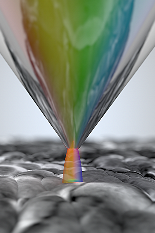Press Release
New Efficiencies in Solar Cells on the Horizon
University of Maryland research group develops new diagnostic imaging technique used to determine solar cell efficiency.
FOR IMMEDIATE RELEASE September 29, 2015
CONTACT:
Kathryn Tracey
(301) 405-4951
ketracey@umd.edu

A novel imaging platform to determine the open-circuit voltage of solar cells with nanoscale spatial resolution is developed by assistant professor Marina Leite's research group at the University of Maryland. The illustration shows a scanning probe microscopy tip used to illuminate a very small region of the photovoltaic device, allowing scientists to now map local variations on this key parameter that determines how well any optoelectronic device operates.
COLLEGE PARK, Md. - Discrepancies between theoretical and actual efficiencies in solar cells plague researchers who need more effective imaging techniques to diagnose inefficiencies in solar cells at operation conditions. Theory indicates that current technologies should be achieving around or above 30% efficiency, but most solar cells are only performing at around 20%. With a new imaging technique developed at the University of Maryland by Assistant Professor Marina Leite, academic and industry researchers will be able to diagnose where solar cells lose efficiency and close the gap between theory and the actual efficiencies experienced by consumers who install solar panels on their homes and businesses.
Leite, a professor from the Department of Materials Science and Engineering and the Institute for Research In Electronics and Applied Physics, sees possibilities beyond solar, remarking, “Our imaging platform can be applied to any type of solar cell, as well as to other optoelectronic devices, such as LEDs and photodetectors. In all cases, we can resolve local variations in Voc and rationally design next-generation devices with improved response.”
Solar cell efficiencies depend on the maximum achievable open-circuit voltage (Voc) generated by the device under illumination. Voc determines how well any photovoltaic device operates, and researchers must be able to measure and image Voc in order to diagnose which processes are adding to or subtracting from cell efficiency.
The new imaging technique presented by Tennyson, et al. is based on a variant of illuminated Kelvin Probe Force Microscopy (KPFM), which is non-destructive imaging technique used to determine the electronic state of a surface. Traditionally, KPFM scans the surface of a solid (like the needle in a record player) and measures the potential difference between the tip of the probe and the surface. Tennyson, et al. take this conventional imaging technique further to demonstrate a “direct correlation between KPFM measurements (light- minus dark-KPFM) and the open-circuit voltage of photovoltaic devices through the measurement of the quasi-Fermi level splitting”. This indirect measurement allows researchers to observe precisely where the Voc is changing with nanoscale spatial resolution
Previous imaging techniques for determining solar cell efficiencies have been performed under vacuum at very cold temperatures (~70K), or with millimeter spatial resolution. The technique developed by Leite's group fills an important gap in the literature surrounding solar cell efficiencies. According to Leite, “[the] platform provides a straightforward and universal way to resolve local variations in the Voc in any type of solar cell with high spatial resolution, complementing regular macroscopic light I-V measurements."
More Information:
Elizabeth M. Tennyson, Joseph L. Garrett, Jesse A. Frantz, Jason D. Myers, Robel Y. Bekele, Jasbinder S. Sanghera, Jeremy N. Munday and Marina S. Leite. "Nanoimaging of Open-Circuit Voltage in Photovoltaic Devices." Advanced Energy Materials. Published online 24 September 2015. http://dx.doi.org/10.1002/aenm.201501142
Visit Professor Leite's web site at: http://leitelab.umd.edu/
About the A. James Clark School of Engineering
The University of Maryland’s A. James Clark School of Engineering is a premier program, ranked among the top 20 in the world. Located just a few miles from Washington, D.C., the Clark School is at the center of a constellation of high-tech companies and federal laboratories, offering students and faculty access to unique professional opportunities.
Our broad spectrum of academic programs, including the world’s only accredited undergraduate fire protection engineering program, is complemented by a vibrant entrepreneurial ecosystem, early hands-on educational experiences, and participation in national and international competitions.
The Clark School is leading research advancements in aerospace, bioengineering, robotics, nanotechnology, disaster resilience, energy and sustainability, and cybersecurity. From the universal product code to satellite radio, SMS text messaging to the implantable insulin pump, our students, faculty, and alumni are engineering life-changing innovations for millions. Learn more at www.eng.umd.edu.